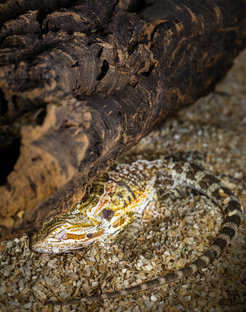Bearded Dragons and Sleep

Humans spend approximately 30% of their lives sleeping. While we know that sleep is crucial to our well-being - just think of how bad we feel after a sleepless night or a transatlantic flight - we still do not fully understand why sleep is important and what role it plays in our survival. We are not the only animals that sleep. Research over the past few decades has shown that most, if not all, animals sleep, although sleep can take different forms (e.g., prolonged, like ours, or intermittent and irregular, like many rodents). In mammals, sleep can be divided into two main phases: deep sleep and rapid eye movement (REM) sleep, which is based on brain activity. These two sleep states (REM and non-REM) have also been observed in birds. Recently, we serendipitously discovered that bearded dragons (a type of reptile) also have these two sleep stages. The fact that REM and Non-REM sleep occur in mammals, birds, and non-avian reptiles suggests that these sleep stages were present in our common ancestor, an animal that lived about 320 million years ago.
Human sleep in adults lasts about 8h each night and contains 5-6 cycles of nonREM + REM: we fall asleep in nonREM and after a little over an hour, transition to REM for 5-10 minutes. This nonREM-REM cycle starts anew again, each time, with a slightly longer REM episode. By the end of the night, we may spend 15-20 minutes in REM before waking up. This cycling activity varies enormously across animals. In cats for example, the cycle lasts 30 minutes only. In mice, it is extremely irregular, and REM does not always follow an episode of nonREM.
What we discovered in dragons is that the cycle is even shorter (2-3 minutes), with equal durations of nonREM and REM) and repeats itself some 300 times every night, with amazing regularity! What this animal offers, therefore, is a system and a brain in which the mechanisms of alternation between nonREM and REM can be studied with an access, repeatability and control that are unique among animals. We thus take advantage of this animal species to examine critical features of brain function that would be very difficult to study in other species. Because what is discovered in one species can often apply to other species (either because of common ancestry or because of evolutionary convergence), what we observe in dragons can inspire direct tests in other species, including humans. This is what happened, for example, with our discovery of the involvement of the claustrum, a mysterious and highly interconnected part of the forebrain, in dragons: recent studies in mice and humans reported similar results, supporting the relevance of comparative approaches and justifying the study of animal species that present unique advantages.
